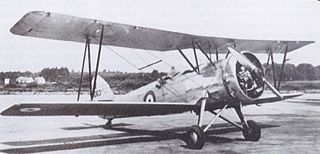
The Hawker Siddeley HS 748 is a medium-sized turboprop airliner originally designed and initially produced by the British aircraft manufacturer Avro. It was the last aircraft to be developed by Avro prior to its absorption into Hawker Siddeley.

The Avro Type 694 Lincoln is a British four-engined heavy bomber, which first flew on 9 June 1944. Developed from the Avro Lancaster, the first Lincoln variants were initially known as the Lancaster IV and V; these were renamed Lincoln I and II. It was the 2nd last piston-engined bomber operated by the Royal Air Force (RAF).

The Avro Anson is a British twin-engine, multi-role aircraft built by the aircraft manufacturer Avro. Large numbers of the type served in a variety of roles for the Royal Air Force (RAF), Fleet Air Arm (FAA), Royal Canadian Air Force (RCAF), Royal Australian Air Force and numerous other air forces before, during, and after the Second World War.

The Lockheed Hudson is a light bomber and coastal reconnaissance aircraft built by the American Lockheed Aircraft Corporation. It was initially put into service by the Royal Air Force shortly before the outbreak of the Second World War and primarily operated by it thereafter. The Hudson was a military conversion of the Model 14 Super Electra airliner, and was the first significant aircraft construction contract for Lockheed — the initial RAF order for 200 Hudsons far surpassed any previous order the company had received.

The Avro 504 is a single-engine biplane bomber made by the Avro aircraft company and under licence by others. Production during World War I totalled 8,970 and continued for almost 20 years, making it the most-produced aircraft of any kind that served in any military capacity during the First World War. More than 10,000 were built from 1913 until production ended in 1932.

The Avro 618 Ten or X was a passenger transport aircraft of the 1930s. It was a licensed version by Avro of the Fokker F.VIIB/3m.

The Cierva C.30 is an autogyro designed by Juan de la Cierva and built under licence from the Cierva Autogiro Company by A V Roe & Co Ltd (Avro), Lioré-et-Olivier and Focke-Wulf.

The Avro 626 is a single-engined British biplane trainer aircraft produced by Avro during the (1918-1939) inter-war period.

The de Havilland DH.60 Moth is a 1920s British two-seat touring and training aircraft that was developed into a series of aircraft by the de Havilland Aircraft Company.

The Avro Type 621 Tutor is a two-seat British radial-engined biplane from the interwar period. It was a simple but rugged basic trainer that was used by the Royal Air Force as well as many other air arms worldwide.

The Armstrong Siddeley Genet Major is a British five-cylinder, air-cooled, radial engine for aircraft, designed and built by Armstrong Siddeley and first run in 1928. It developed 140 horsepower (104 kW). In Royal Air Force use the seven-cylinder version was known as the Civet I. The Feliform names used are in line with company convention, the Genet and Civet both being large cat-like carnivores.

The Avro Avian is a series of British light aircraft designed and built by Avro in the 1920s and 1930s. While the various versions of the Avian were sound aircraft, they were comprehensively outsold by the de Havilland Moth and its descendants.

The Avro Club Cadet was a 1930s single-engined British biplane trainer aircraft, designed and built by Avro as a development of the earlier Cadet. It was planned for private and club use and, unlike the Cadet, was fitted with folding wings.
The Avro 636 was a single-engined British fighter-trainer built by Avro in the mid-1930s. Four were built for the Irish Air Corps.

The Avro 641 Commodore was a British single-engine five-seat cabin biplane built by Avro in the mid-1930s for private use. A total of only six were built, including the prototype.

The Avro 701 Athena is a British advanced trainer aircraft built by Avro in the late 1940s. It was designed to replace the North American Harvard in the Royal Air Force, but was bought only in small numbers, the competing Boulton Paul Balliol being preferred.

The Armstrong Siddeley Genet is a five-cylinder, air-cooled, radial engine for aircraft use built in the UK, first run in 1926. It developed 80 hp at 2,200 rpm in its final form and was a popular light aircraft powerplant. Following the company tradition with a slight deviation the engine was named after the Genet, a catlike animal of the same order but different family.

The de Havilland DH.75 Hawk Moth was a 1920s British four-seat cabin monoplane built by de Havilland at Stag Lane Aerodrome, Edgware.

The Cierva C.19 was a 1930s British two-seat autogyro, designed by Spanish engineer Juan de la Cierva. It was built by Avro as the Avro Type 620. It proved to be the most successful and widely produced of the early de la Cierva designs.

The Avro 642 Eighteen was a 1930s British monoplane airliner. Only two were built — one twin-engined and the other four-engined. The original had a circular partially glazed nose, but this was changed to a more traditional one. It used the wing of the Avro 618 Ten, which was a license produced Fokker V.II.





















